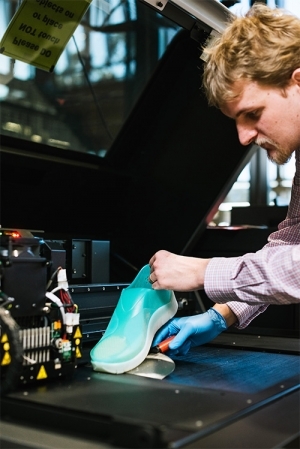Design takes centre stage at CADET
Research news
Many of us take the simplicity of everyday items for granted, but it is the creativity of industrial designers that we have to thank for most of our consumer goods – and such 20th century design masterpieces as the Mini Cooper, the Hasselblad camera or even the Dyson bagless vacuum cleaner.
Design has taken centre stage at Deakin’s new high tech Centre for Advanced Design in Engineering Training (CADET), as part of a whole new approach to preparing the engineers, industrial designers and entrepreneurs of the future.
The $55 million Centre is attracting national and international interest for both its cutting edge technologies – including a fully immersive virtual reality CAVE that allows designers to test virtual prototypes – and its redeveloped, design-focussed curriculum that brings industrial design and mechanical, civil, electrical and mechatronics engineering students together to work on real projects with industry.
In a ground-breaking move, Deakin is preparing to launch its first Industrial Design degree next year within its Engineering School (instead of the usual architecture or arts schools) in a bid to better prepare graduates to capitalise on technological opportunities.
“Industrial design is paramount for the future innovation required in Australia, to transition from a resources economy into a smarts economy,” said the Head of Deakin’s School of Engineering Professor Guy Littlefair.
“The CADET facility provides one of the very best environments for students to work on collaborative, industry-focussed design projects, where I hope the future James Dyson (founder of the Dyson Company) or Jony Ive (Chief Designer of Apple) will be mentored.”
Professor Littlefair and Deakin’s new Professor of Industrial Design, Ian Gibson, have led development of the new program, working in consultation with Engineering Australia and the Design Institute of Australia.
“We have no way of knowing exactly what the world will look like in ten years, but we can equip our students to be versatile enough to adapt to new situations,” Professor Gibson said.
“The curriculum takes a problem-based, project-oriented approach, so students see why engineering and design skills are needed. They will also learn the equally important “softer” skills, such as project management and entrepreneurialism, right from the beginning.”
“In line with global trends, students will be encouraged to think about technological and electronic applications, as well as materials and manufacturing materials or processes.”
“If we look at trends in the USA, for instance, the number of unicorn companies (worth US$1 billion before they go public) is rapidly increasing. This is being enabled by fundraising, a new generation of technology, a rising share market, design and risk-taking. Mega-startup companies, such as Snapchat, Pinterest and Airbnb, which didn’t exist five years ago, are very often based around design. These companies are able to address and meet problems for a large number of users – this is the fundamental role of industrial design.”
“There is a worldwide shift towards adaptable industries that are adopting diverse product lines. For instance, at the multinational 3M, which is famous for designing Post-it notes, 30 per cent of the company’s revenues must come from products developed in the past four years.”
Prof Gibson added that the project-based approach of the Industrial Design degree will allow students to work on areas that interest them, such as sports or medical technology, and the discipline suits people who like to think outside the box and have previously worked on their own design ideas at school or home.
“Students also get to spend a two-month placement with an industrial host. Companies like Apple, 3M, Dyson or Rolls Royce have extensive intern programs that could be available or, for local opportunities, design-oriented companies like Cotton On, Quicksilver or Baum Cycles, could be options.”
Share this story

